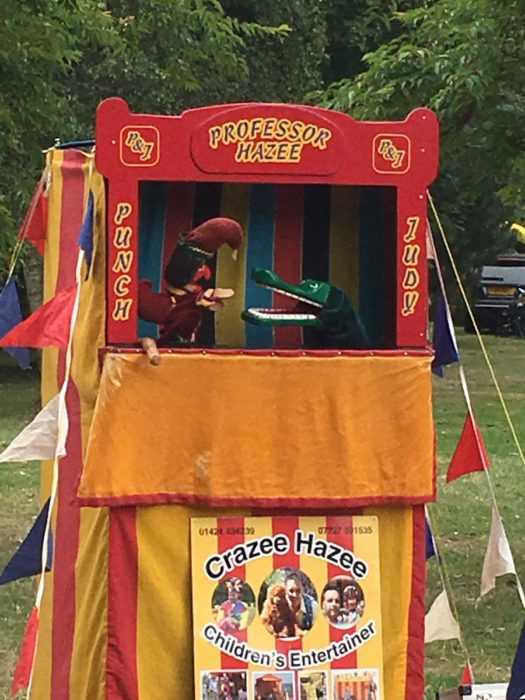We missed Special Guest Star Bobby Davro, who had opened the Hotham Park Country Fair in Bognor Regis, but watching the Punch and Judy show at the fair felt like a rite of passage for our five-year old son, George, in the company of his parents and great aunt and uncle. The show was put together by Professor Hazee, aka children’s entertainer Crazee Hazee, and in the time-honoured fashion featured a series of sketches involving squeaky-voiced Punch and another character: Judy, the baby, the crocodile, the policeman…
As George quickly learnt the correct response of “oh, no, it isn’t!” to Punch’s “oh, yes, it is!”, it felt as though he was being inducted in Englishness. Punch and Judy indeed appeared in the list of the first twelve icons of England selected as part of the ICONS project in 2006, commissioned by the Department of Culture, Media and Sport. They sat alongside Stonehenge, the Routemaster bus and a cup of tea. Punch and Judy played at the Festival of Britain in 1951, and the Millennium Dome exhibition in Greenwich in 2000. A British export, Punch and Judy is performed in various English-speaking countries, including the United States. One William Judd, on emigration to the USA in 1867, even set up a business providing the items needed by travelling Punch and Judy shows in that country. A crocodile cost $2, a baby 50 cents. Punch and Judy shows performed across continental Europe these days are often set in the context of showcasing Britain and its popular culture.
The Punch and Judy tradition is a long one, dating back more than 350 years. Punch’s birthday is traditionally set as 9 May 1662, the date of the first recorded performance of a show featuring the character. The author of the account mentioning this was none other than diarist Samuel Pepys, who caught the show in London’s Covent Garden. There is a plaque in the portico of St Paul’s Church to mark the occasion, and across the square, the Punch and Judy public house is invariably packed with tourists.
But here’s the interesting thing. If a Punch and Judy show is today considered an icon of Englishness, that first performance is referred to in Pepys’ diary as an “Italian puppet play”. The puppeteer was one Pietro Gironde from Bologna, known to his seventeenth-century audience as Signor Bologna. Bologna was not alone. Following the restoration of Charles II and the demise of Puritan dislike of theatre, there was a boom in puppet shows in England, often brought by puppeteers from continental Europe. The character now named Punch was then known as Pulcinella, an establishment-baiting pot-bellied hunchback, who was in turn drawn from the Italian commedia dell’arte tradition. Always a subversive, Pulcinella’s name is said to come from the Italian “pulcino” (chick), a reference to his beak-like face and high-pitched voice. The slapstick used by Punch with which to thwack everyone he encounters also comes from commedia dell’arte.
So by the time Pulcinella arrived on the shores of England, performance by live actors had transformed into one by marionettes. Once here, the Italian Pulcinella was to evolve again, into the English Punch. The kind of marionette show Pepys would have seen in 1662 was expensive to stage, requiring several puppeteers, and difficult to transport. By the end of the 18th century these marionette shows had been replaced by more straightforward glove puppet affairs. There was just one puppeteer, who operated two puppets in the narrow, portable booths familiar today. The glove puppet format allowed Punch to become more violent, too.
Punch acquired a wife, originally called Joan. By the nineteenth century, Joan had become Judy. With the coming of the railways, and the development of seaside resorts in Britain, Punch and Judy shows established themselves as an integral part of the day trip.
The characters in a typical Punch and Judy performance have changed to some degree over the years. The Devil is seen less frequently nowadays, and the hangman has almost entirely disappeared. Performances typically include reference to contemporary politics and culture, as an appeal to adults in the audience. But continuity is more marked than change. Some even claim that the title of the puppeteers, “Professors”, dates right back to a decree of Charles II.
The storylines are problematic, with their underpinning themes of domestic violence. Indeed, debates about the violence in the performances are almost as old as the characters themselves. But anarchic, anti-establishment Punch just laughs off his critics with a cry of “that’s the way to do it!”
The story of Mr Punch provides an example of how what are often perceived as quintessentially British traditions have often been shaped by an openness to ideas and influences from the wider world.

